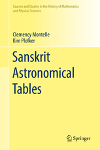- About MAA
- Membership
- MAA Publications
- Periodicals
- Blogs
- MAA Book Series
- MAA Press (an imprint of the AMS)
- MAA Notes
- MAA Reviews
- Mathematical Communication
- Information for Libraries
- Author Resources
- Advertise with MAA
- Meetings
- Competitions
- Programs
- Communities
- MAA Sections
- SIGMAA
- MAA Connect
- Students
- MAA Awards
- Awards Booklets
- Writing Awards
- Teaching Awards
- Service Awards
- Research Awards
- Lecture Awards
- Putnam Competition Individual and Team Winners
- D. E. Shaw Group AMC 8 Awards & Certificates
- Maryam Mirzakhani AMC 10 A Awards & Certificates
- Two Sigma AMC 10 B Awards & Certificates
- Jane Street AMC 12 A Awards & Certificates
- Akamai AMC 12 B Awards & Certificates
- High School Teachers
- News
You are here
Sanskrit Astronomical Tables

Publisher:
Springer
Publication Date:
2019
Number of Pages:
308
Format:
Hardcover
Series:
Sources and Studies in the History of Mathematics and Physical Sciences
Price:
119.99
ISBN:
978-3-319-97036-3
Category:
Monograph
[Reviewed by , on ]
Scott Guthery
08/24/2019
From the Introduction:
If the ongoing and emerging successors to Pingree’s endeavors are to continue progressing in their mammoth task of mapping and rationalizing the vast corpus of Sanskrit scientific manuscripts, they will need an up-to-date, more accessible guide to Sanskrit astronomical tables... Such a guide is what the present work seeks to provide.
And it does. The authors and the publisher are to be congratulated for bringing to the market and our reference shelves a thorough, well-organized, deeply-researched, and beautifully presented book. In addition to the full-color (yes, full-color) illustrations of manuscript pages, the authors include three helpful appendices: Inventory of Sanskrit table texts, Classification schemata and parameters, and Sanskrit technical terms.
The authors made two editorial decisions that are worthy of note. First, they elected to use the transliteration of Sanskrit terms into the Latin alphabet rather than translating the terms (assuming this would be possible) into English. For some, this rendering of the terms might present small speed bumps as reading starts but very quickly an understanding of what the word connotes emerges and the speed bumps become reliable lane markers. A translation would necessarily scramble the pure meaning of the term with the meaning of the word to which the term was translated.
Second, the discussion of each aspect of Sanskrit tables is a deep-dive analysis of a particular table. This form of mathematical discourse is reminiscent of how J.-L. Lagrange, Maria Montessori, and Warren Colburn all taught mathematics. The example of a tabular property is not bolted to the side of a discourse cleansed of particulars. Rather, by working through the details of the example one comes to an understanding (there’s that phrase again) of the property that one can use.
Chapter 1 of Sanskrit Astronomical Tables is the only place we find linkages between the mathematical practitioners who built these tables and table makers working in other cultures and then only fleetingly. The chapter is primarily devoted to getting the reader spun up on Sanskrit terminology. Chapter 2, Content and Classification of Table Texts, describes the mathematical context of the tables. Topics include the computation of astronomical quantities, the mathematical modeling of astronomical phenomena, parameter estimation, interpolation, and precision. Chapter 3 is about table construction but also documents the various collections, archives, and libraries in which the tables are resting today.
Chapter 4, Elements of Table Texts, is the largest chapter and the heart of the book. The authors say in the introduction to the chapter that they “...have undertaken in this chapter to describe a ‘standard’ selection of individual tables as separate elements of components of diverse kinds of table texts.’’ The elements discussed include ecliptic declination, lunar latitude, and meantime correction. Chapter 5, The Evolution of the Table-Text Genre, contains material of interest far beyond mathematical tables per se; it is about how we describe regularity. Keeping with the editorial spirit of the book, the discussion is what the chapter title promises but the insights that it engenders are much broader. In the last chapter, the authors pass the baton to the successors they mentioned in the introduction.
I am by no means qualified to comment on the particulars of the authors’ analyses of the manuscripts they examined. I can say that I enjoyed reading the book and that it broadened my thinking about what mathematics is and what mathematicians do. By example, the book demonstrates that mathematics is much more than a theorem-proof death march. Even if you think you know all you need to know about Sanskrit astronomical tables you too will, I believe, find the book a good read.
Scott Guthery is the founder and editor of Docent Press and co-founder of Life-Notes.
See the publisher's web page.
- Log in to post comments




